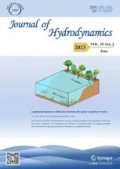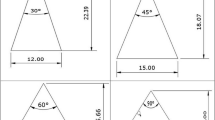Abstract
The cavitation is ubiquitous in the water delivery system of high hydraulic head navigation locks. This paper studies the choked cavitation characteristics of the gap flows in the valve lintel of the navigation locks and analyzes the critical self-aeration conditions. The cavitation gap flow in the valve lintel is experimentally and numerically investigated. A visualized 1:1 full-scale slicing model is designed, with a high-speed camera, the details of the cavitation flow is captured without the reduced scale effect. Moreover, the numerical simulations are conducted to reveal the flow structures in the gap. The experimental results show that the flow pattern of the gap flow in the valve lintel could be separated into four models, namely, the incipient (1) the developing, (2), the intensive, (3), and the choked (4) cavitation models. The numerical simulation results are consistent with the experimental data. The choked cavitation conditions are crucial to the gap flow in the valve lintel. When the choked cavitation occurs, the gap is entirely occupied by two cavitation cloud sheets. The gap pressure then decreases sharply to the saturated water vapor pressure at the operating temperature. This water vapor pressure is the ultimate negative pressure in the gap that remains unchanged with the continuous decrease of the downstream pressure. The volumetric flow rate reaches a peak, then remains constant, with the further decrease of the pressure ratio or the cavitation number. At the choking point, the volumetric flow rate is proportional to the root mean square of the difference between the upstream pressure (absolute pressure) and the saturated pressure of the water. Moreover, the pressure ratio is linearly correlated with the downstream cavitation number with a slope of (1 + Ϛc).
Similar content being viewed by others
References
Luo X. W., Ji B., Tsujimoto Y. A review of cavitation in hydraulic machinery [J]. Journal of Hydrodynamics, 2016, 28(3): 335–358.
Ghassemi H., Fasih H. F. Application of small size cavitating venturi as flow controller and flow meter [J]. Flow Measurement and Instrumentation, 2011, 22(5): 406–412.
Gągol M., Przyjazny A., Boczkaj G. Wastewater treatment by means of advanced oxidation processes based on cavitation-A review [J]. Chemical Engineering Journal, 2018, 338: 599–627.
Brinkhorst S., Lavante E. V., Wendt G. Experimental and numerical investigation of the cavitation-induced choked flow in a herschel venturi-tube [J]. Flow Measurement and Instrumentation, 2017, 54: 56–67.
Yan Y., Thorpe R. B. Flow regime transitions due to cavitation in the flow through an orifice [J]. International Journal of Multiphase Flow, 1990, 16(6): 1023–1045.
Long X., Zhang J., Wang J. et al. Experimental investigation of the global cavitation dynamic behavior in a venturi tube with special emphasis on the cavity length variation [J]. International Journal of Multiphase Flow, 2017, 89: 290–298.
Cioncolini A., Scenini F., Duff J. et al. Choked cavitation in micro-orifices: An experimental study [J]. Experimental Thermal and Fluid Science, 2016, 74: 49–57.
Tomov P., Khelladi S., Ravelet F. et al. Experimental study of aerated cavitation in a horizontal venturi nozzle [J]. Experimental Thermal and Fluid Science, 2016, 70: 85–95.
Abdulaziz A. M. Performance and image analysis of a cavitating process in a small type venturi [J]. Experimental Thermal and Fluid Science, 2014, 53: 40–48.
Harada K., Murakami M., Ishii T. PIV measurements for flow pattern and void fraction in cavitating flows of He II and He I [J]. Cryogenics, 2006, 46(9): 648–657.
Decaix J., Balarac G., Dreyer M. et al. RANS computations of tip vortex cavitation [J]. Journal of Physics: Conference Series, 2015, 656: 12183.
Argyropoulos C. D., Markatos N. C. Recent advances on the numerical modelling of turbulent flows [J]. Applied Mathematical Modelling, 2015, 39(2): 693–732.
Shih T., Liou W. W., Shabbir A. et al. A new k-ε eddy viscosity model for high reynolds number turbulent flows [J]. Computers and Fluids, 1995, 24(3): 227–238.
Ashrafizadeh S. M., Ghassemi H. Experimental and numerical investigation on the performance of small-sized cavitating venturis [J]. Flow Measurement and Instrumentation, 2015, 42: 6–15.
Charrière B., Goncalves E. Numerical investigation of periodic cavitation shedding in a Venturi [J]. International Journal of Heat and Fluid Flow, 2017, 64: 41–54.
Ji B., Luo X. W., Arndt R. E. A. et al. Large eddy simulation and theoretical investigations of the transient cavitating vortical flow structure around a NACA66 hydrofoil [J]. International Journal of Multiphase Flow, 2015, 68: 121–134.
Long X., Cheng H., Ji B. et al. Large eddy simulation and Euler-Lagrangian coupling investigation of the transient cavitating turbulent flow around a twisted hydrofoil [J]. International Journal of Multiphase Flow, 2018, 100: 41–56.
Wang C. C., Liu Y., Chen J. et al. Cavitation vortex dynamics of unsteady sheet/cloud cavitating flows with shock wave using different vortex identification methods [J]. Journal of Hydrodynamics, 2019, 31(3): 475–494.
Huang B., Zhao Y., Wang G. Large eddy simulation of turbulent vortex-cavitation interactions in transient sheet/cloud cavitating flows [J]. Computers and Fluids, 2014, 92: 113–124.
Long X., Long Y., Wang W. et al. Some notes on numerical simulation and error analyses of the attached turbulent cavitating flow by LES [J]. Journal of Hydrodynamics, 2018, 30(2): 369–372.
Ji B., Long Y., Long X. et al. Large eddy simulation of turbulent attached cavitating flow with special emphasis on large scale structures of the hydrofoil wake and turbulence-cavitation interactions [J]. Journal of Hydrodynamics, 2017, 29(1): 27–39.
Nouri N. M., Mirsaeedi S. M. H., Moghimi M. Large eddy simulation of natural cavitating flows in Venturi-type sections [J]. Proceedings of the Institution of Mechanical Engineers, Part C: Journal of Mechanical Engineering Science, 2011, 225(2): 369–381.
ANSYS FLUENT theory guide, release 14.0 [R]. ANSYS INC., 2014.
Araoye A. A., Badr H. M., Ahmed W. H. Investigation of flow through multi-stage restricting orifices [J]. Annals of Nuclear Energy, 2017, 104: 75–90.
Kalitzin G., Medic G., Iaccarino G. et al. Near-wall behavior of RANS turbulence models and implications for wall functions [J]. Journal of Computational Physics, 2005, 204(1): 265–291.
Iyer C. O., Ceccio S. L. The influence of developed cavitation on the flow of a turbulent shear layer [J]. Physics of Fluids, 2002, 14(10): 3414–3431.
šarc A., Stepišnik-Perdih T., Petkovšek M. et al. The issue of cavitation number value in studies of water treatment by hydrodynamic cavitation [J]. Ultrasonics Sonochemistry, 2017, 34: 51–59.
Zhang Y., Tian Y., Zhang Z. et al. Experimental and numerical study of cavitating flow with suction in a mixing reactor for water treatment [J]. Chemical Engineering Journal, 2018, 353: 796–804.
Mishra C., Peles Y. Cavitation in flow through a microorifice inside a silicon microchannel [J]. Physics of Fluids, 2005, 17(1): 13601.
Molina S., Salvador F. J., Carreres M. et al. A computational investigation on the influence of the use of elliptical orifices on the inner nozzle flow and cavitation development in diesel injector nozzles [J]. Energy Conversion and Management, 2014, 79: 114–127.
Author information
Authors and Affiliations
Corresponding author
Additional information
Project supported by the National Key Research and Development Program of China (Grant No. 2016YFC0402007), the National Nature Science Foundation of China (Grant No. 51779151).
Biography
Bo Wu (1991-), Male, Ph. D. Candidate, E-mail: bowu1991@whu.edu.cn
Rights and permissions
About this article
Cite this article
Wu, B., Hu, Ya., Wang, X. et al. Experimental and CFD investigations of choked cavitation characteristics of the gap flow in the valve lintel of navigation locks. J Hydrodyn 32, 997–1008 (2020). https://doi.org/10.1007/s42241-020-0065-6
Received:
Revised:
Accepted:
Published:
Issue Date:
DOI: https://doi.org/10.1007/s42241-020-0065-6



